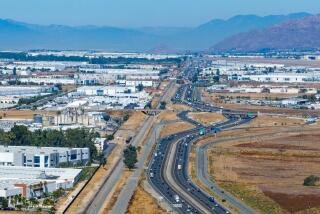Simi Valley Studies Safety of New Mall
- Share via
Although groundbreaking on its new regional mall will not begin until summer, Simi Valley has already spent more than $1 million to study the seismic safety of the shopping center site on the city’s west end.
The $300-million Simi Town Center, an open-air retail and housing development, will be situated on 129 acres north of the 118 Freeway, between 1st Street and Erringer Road.
Because the site is in an area of potential earthquake activity, the city tested fault lines on or near the proposed center for nearly a year until it was satisfied the project would survive any quake that was likely to occur.
“We know we’re in really good shape on this piece of property,” said Assistant City Manager Brian Gabler.
“We’re very confident on the geotechnical stability of the site, and that’s the position we want to be in,” he added.
The first phase of the project is to include a 625,000-square-foot outdoor mall -- similar to the Promenade at Westlake -- with a Macy’s and a Robinsons-May, about 120 smaller specialty stores and several restaurants. In a separate “Town and Country” section there will be 225,000 to 250,000 square-feet of space for big-box retailers, such as a home-improvement store, and a 500-unit luxury apartment complex.
Developers Corti Gilchrist Partnership and Finley Group in San Diego and Forest City Enterprises of Cleveland have entitlements to expand the mall to 840,000 square feet, by enlarging the Macy’s, adding a third department store and building a 150-room hotel and up to 100,000 square feet of offices.
Consultants hired by the city, which owns the western 33 acres of the site, spent months digging huge trenches -- down as far as 60 feet and as long as 240 feet--to reach bedrock and collect samples for carbon dating, to determine how long faults had been inactive.
Computer models were used to review known quake activity within a 62-mile radius from 1800 to 2002, and to estimate the level of damage a magnitude-6.9 earthquake could cause.
Ten years ago, the magnitude-6.7 Northridge quake rocked Simi Valley -- buckling dozens of streets, rendering 175 buildings inhabitable and causing more than $425 million in damage to the city.
That was along the East Oakridge fault, which Gabler said is less than five miles southeast of the Simi-Santa Rosa fault.
The Simi-Santa Rosa fault is the largest of nine faults identified at the Town Center site. The fault is considered active because it has had some seismic movement within the past 11,000 years.
This fault zone, which starts west of Camarillo’s Spanish Hills neighborhood and snakes eastward through Las Posas Hills and the Tierra Rejada Valley toward the northwest corner of Simi Valley, cuts across the southeastern edge of the Town Center site.
Of the remaining eight faults, all but one was determined inactive.
That one, known as fault 7, and the Simi-Santa Rosa fault are too close to the freeway for geologists to dig the deep trenches needed to properly study their history of movement.
As a precaution, fault 7 also is considered active, according to Gabler.
“Do we believe it’s inactive? Yes. Can we prove it at this point? No,” he said, adding that the layout of the shopping complex was altered to accommodate fault 7. “Now the design is such that just a detention basin is there. It didn’t really hurt us very much.”
The larger Simi-Santa Rosa fault also affected the center’s design, Gabler said, requiring the overall Town Center design to be adjusted away from the southern edge of the site.
Now, roads and parking lots -- allowed by state building codes if they are at least 50 feet from an active fault line -- are the only things planned on that portion of the site.
“In the long-run it provides for a better project. The vistas will be a little better,” Gabler said. “You’re pulling the buildings off the freeway. Retailers like their buildings right at the freeway, so you can see their signs, but aesthetically it’s more attractive not to see a line of buildings.”
Because the freeway is about 15 feet below the grade of the shopping center, motorists will see landscaping and then stores at a few locations in the distance as they drive past the site, Gabler said.
In addition to the city’s seismic testing, which, at $1,073,000, cost nearly six times as much as the $187,000 spent to study all other environmental aspects of the Town Center project, the developers must hire a geotechnical engineer to recommend how best to grade the site and compact the foundation to reduce the likelihood of major structural failure in the event of a quake.
More to Read
Sign up for Essential California
The most important California stories and recommendations in your inbox every morning.
You may occasionally receive promotional content from the Los Angeles Times.













